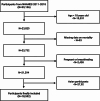Association of weight-adjusted waist index with all-cause mortality among non-Asian individuals: a national population-based cohort study
- PMID: 38862996
- PMCID: PMC11167926
- DOI: 10.1186/s12937-024-00947-z
Association of weight-adjusted waist index with all-cause mortality among non-Asian individuals: a national population-based cohort study
Abstract
Introduction: The Weight-Adjusted Waist Index (WWI) is a new indicator of obesity that is associated with all-cause mortality in Asian populations. Our study aimed to investigate the linear and non-linear associations between WWI and all-cause mortality in non-Asian populations in the United States, and whether WWI was superior to traditional obesity indicators as a predictor of all-cause mortality.
Methods: We conducted a cohort study using data from the 2011-2018 National Health and Nutrition Examination Survey (NHANES), involving 18,592 participants. We utilized Cox proportional hazard models to assess the association between WWI, BMI, WC, and the risk of all-cause mortality, and performed subgroup analyses and interaction tests. We also employed a receiver operating characteristics (ROC) curve study to evaluate the effectiveness of WWI, BMI, and WC in predicting all-cause mortality.
Results: After adjusting for confounders, WWI, BMI, and WC were positively associated with all-cause mortality. The performance of WWI, BMI, and WC in predicting all-cause mortality yielded AUCs of 0.697, 0.524, and 0.562, respectively. The data also revealed a U-shaped relationship between WWI and all-cause mortality. Race and cancer modified the relationship between WWI and all-cause mortality, with the relationship being negatively correlated in African Americans and cancer patients.
Conclusions: In non-Asian populations in the United States, there is a U-shaped relationship between WWI and all-cause mortality, and WWI outperforms BMI and WC as a predictor of all-cause mortality. These findings may contribute to a better understanding and prediction of the relationship between obesity and mortality, and provide support for effective obesity management strategies.
Keywords: All-cause mortality; NHANES; Obesity; Weight-adjusted-waist.
© 2024. The Author(s).
Conflict of interest statement
All authors declare that they have no competing financial interests.
Figures




References
-
- Network GBDC. Global burden of Disease Study 2015 (GBD 2015) obesity and overweight prevalence 1980–2015. In.: IHME Seattle; 2017.
-
- Whitlock G, Lewington S, Sherliker P, Clarke R, Emberson J, Halsey J, Qizilbash N, Collins R, Peto R. Body-mass index and cause-specific mortality in 900 000 adults: collaborative analyses of 57 prospective studies. Lancet. 2009;373(9669):1083–96. doi: 10.1016/S0140-6736(09)60318-4. - DOI - PMC - PubMed
MeSH terms
LinkOut - more resources
Full Text Sources
Medical

